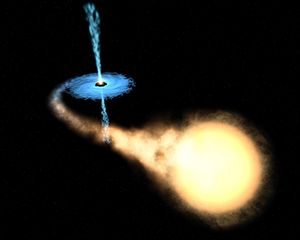|
Muñoz-Darias, Teo Black Holes are one of the most exciting objects in The Universe. They are not visible by definition, but can be studied by looking at the effects they produce in matter close enough to them. This can be done in X-ray binaries. Here, a normal star (like the Sun) is so close to a black hole that part of its material feels stronger the gravitational attraction of it than that of the star itself. This matter is removed from the star, and falls onto the black hole through one of the most energetic processes in the universe: accretion. During this process an accretion disc around the black hole is formed. It is there where we can see a black hole at work. X-ray binary: the normal star (light yellow) is transferring material onto a black hole. An accretion disc is formed (blue).
This project is focussed on studying the innermost part of accretion discs, where the matter is only a few kilometers from the black hole. This region is very hot and can be observed using the X-ray satellites we have currently operative in orbit: Rossi X-ray Timing explorer (RXTE), XMM-Newton, Chandra and Swift. Thanks to these instruments we can measure the amount of light released by an X-ray binary every single millisecond (timing), and the energy distribution of this emission as a function of time (spectral variability). Different effects of General Relativity in presence of a strong gravitational field are encoded in these two observables, but also some of the properties of the accretion physics itself. During the last years it has been clearly proven that the behavior of spectral variability and timing are related. In other words, for a particular spectral pattern a particular timing behavior is generally observed and vice-versa. This phenomenology has been seen in several X-ray binaries, leading to the definition of the so-called 'states'. These correspond to different configurations of these two observables and they are usually observed cyclically in most of the systems. However, we still do not know how many different states there are, and specially, how they are connected to the black hole physics.
 Rossi X-ray Timing Explorer orbiting around the Earth
Since the launch of RXTE in 1996 more than 25 Black hole binaries have been deeply observed, being now possible to study the overall behaviour of both, timing and spectral variability. By performing an homogeneous analysis of these sources we expect to derive general conclusions, which will provide a firm observational ground to test the existing theoretical models of black hole and accretion physics.
|




